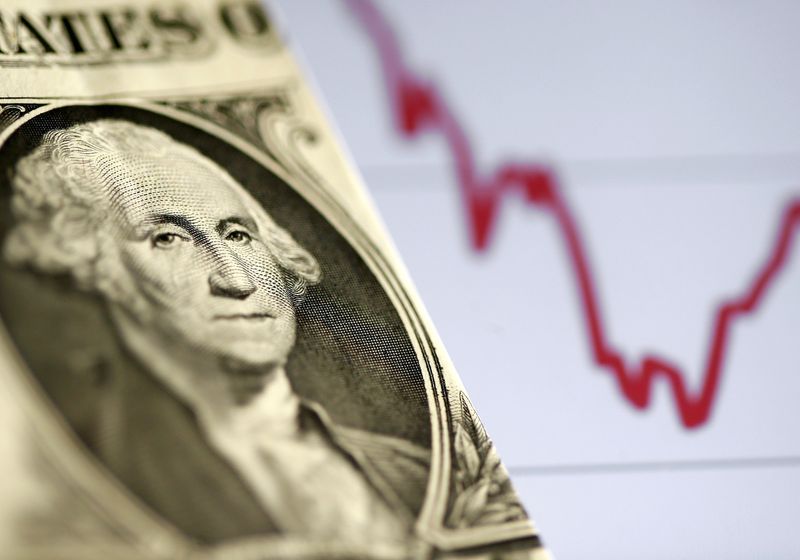(Reuters) - As the second quarter gets underway, the biggest question is when soaring inflation will finally peak.
Federal Reserve minutes and a Reserve Bank of Australia meeting will provide insights on rate setters' thinking. Resilience in stocks and Russia's rouble could be put to the test.
Here's your week ahead in markets from Kevin Buckland in Tokyo, Ira Iosebashvili in New York, Tommy Wilkes, Marc Jones and Dhara Ranasinghe in London.
1/FED UP
Judging by the, albeit brief, inversion of a closely watched part of the Treasury yield curve, U.S. recession risks are rising.
An inverted curve has a solid track record for predicting recessions, but how to interpret recent bond moves presents a conundrum for investors. After the Federal Reserve's March 16 meeting offered a glowing assessment of the economic outlook, stocks are taking the bond selloff in their stride.
On Wednesday, minutes of that Fed meeting should show how policymakers view the outlook. They've already flagged bigger rate hikes to tame inflation, which is at four-decade highs. Also key would be details on how quickly the Fed might reduce its $9 trillion balance sheet, a risk some believe markets are underestimating.
Graphic: US Fed balance sheet and bond yields - https://fingfx.thomsonreuters.com/gfx/mkt/dwpkrqkwavm/Pasted%20image%201648685657247.png
2/ WHEN DOVES BUY
The Bank of Japan has put its money where its mouth is, proving its position as the world's most dovish major central bank. Its standing offer to buy benchmark government bonds signals a potent defence of its yield curve control policy.
The effect of that binge is debatable: yields have only eased slightly from six-year highs, and that arguably had as much to do with U.S. Treasury yields declining from multi-year peaks.
And there's a collateral casualty of the BOJ's uber-easing: the yen, which has plumbed depths not seen since 2015. While the BOJ maintains a weaker currency is overall positive for the economy, jawboning by a queue of government officials suggests a differing view.
Australia's central bank meanwhile meets on Tuesday and while a policy change isn't expected, the bank may go further in laying groundwork for a rate hike. Markets expect one around June.
Graphic: Japan's 10-year bond yield, and the yen - https://fingfx.thomsonreuters.com/gfx/mkt/gkvlgqjllpb/japantheme.PNG
3/ BOUNCEBACK-ABILITY
Two-weeks ago Wall Street's S&P 500 and MSCI's main world stocks index were both down 14% for the year and the Nasdaq was officially in minus 20% "bear" market territory.
Now? Though the war in Ukraine rages on and interest rates are on the up, the S&P 500 is back to within 5% of its all-time high, MSCI World has recovered half of its drop and the Nasdaq is down a more manageable 8%.
Analysts hope that as and when the dust settles, corporate earnings will still look okay, and that the dreaded "stagflation" scenario will be avoided. TINA, or There Is No Alternative, is still alive and well it seems.
The next earnings season is approaching but if the Russia-Ukraine crisis does lead to a new Iron Curtain, it might get harder for stocks to defy gravity.
Graphic: World stocks shaken, but just for a while - https://fingfx.thomsonreuters.com/gfx/mkt/zdpxojqawvx/Pasted%20image%201648644317527.png
4/ REBOUND FOR REAL?
The rouble has staged a remarkable recovery from the record lows hit in the days following Russia's Feb. 24 invasion of Ukraine. In onshore, and offshore markets, where Western institutions trade with non-sanctioned Russian entities, the rouble is almost back to where it was in the run-up to the invasion.
The rise is partly down to capital controls that have suppressed rouble selling and artificially inflated the currency. But there is also a genuine improvement in Russia's balance of payments as imports collapse and soaring energy prices increase export revenues.
President Vladimir Putin's demand for rouble payments for gas, and whether European buyers agree, could be the next test for whether demand for the currency is real or engineered.
Graphic: Russian rouble vs U.S. dollar- https://fingfx.thomsonreuters.com/gfx/mkt/lbpgnmwjavq/rouble%20vs%20dollar.PNG
5/ END OF AN ERA
While the U.S. yield curve inverted, a sea change was taking place in euro zone bond markets with German, French and Dutch two-year debt yields popping above 0% for the first time since 2014.
Yields across the bloc ended March with their biggest monthly surge in around a decade, on expectations the ECB will soon push its minus 0.5% depo rate to 0% and above.
That would be a key moment for negative-yielding debt, global volumes of which surged above $18 trillion in 2020. Savers, banks and pension funds should all benefit; risky corporate debt and emerging markets that gained from investors' "hunt for yield" may lose out.

But calling a trend change in these volatile times is not easy. Coming days could show if yield moves back above 0% are really durable.
Graphic: Negative yields on their way out?- https://fingfx.thomsonreuters.com/gfx/mkt/klvykjmnevg/HEATMAP3103.PNG